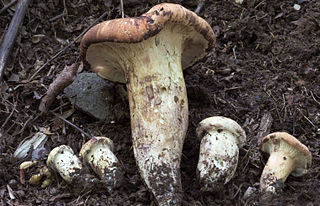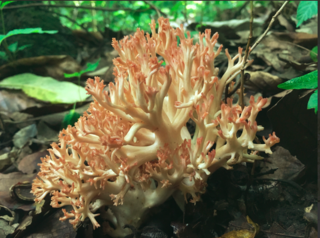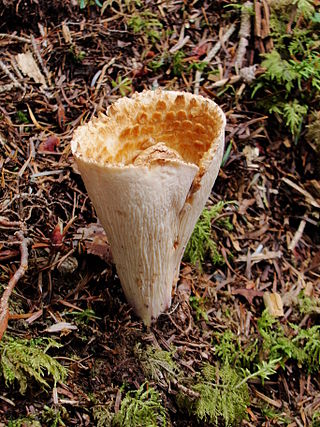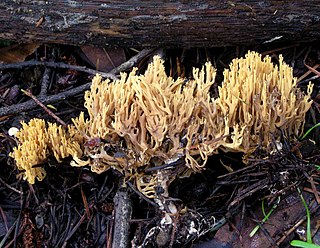
Amanita cokeri, commonly known as Coker's amanita and solitary lepidella, is a poisonous mushroom in the family Amanitaceae. First described as Lepidella cokeri in 1928, it was transferred to the genus Amanita in 1940.

Gomphus is a genus of cantharelloid fungi in the family Gomphaceae. Once presumed to be related to chanterelles, molecular study has shown them to be allied with stinkhorns and fairy clubs. The type species of the genus is the pig's ear (G. clavatus).

The Gomphales are an order of basidiomycete fungi. Some or all families belonging to Gomphales have been sometimes included in the order Phallales, the now-obsolete Ramariaceae was also previously included in Cantharellales. Recent phylogenetic analyses include in Gomphales the families of the original description of the order by Walter Jülich, with addition of Clavariadelphaceae. According to one 2008 estimate, the Gomphales contain 18 genera and 336 species.

Turbinellus floccosus, commonly known as the scaly vase, or sometimes the shaggy, scaly, or woolly chanterelle, is a cantharelloid mushroom of the family Gomphaceae native to Asia and North America. It was known as Gomphus floccosus until 2011, when it was found to be only distantly related to the genus's type species, G. clavatus. It was consequently transferred from Gomphus to Turbinellus. The orange-capped vase- or trumpet-shaped fruiting bodies may reach 30 cm (12 in) high and 30 cm (12 in) wide. The lower surface, the hymenium, is covered in wrinkles and ridges rather than gills or pores, and is pale buff or yellowish to whitish.

The genus Ramaria comprises approximately 200 species of coral fungi. Several, such as Ramaria flava, are edible and picked in Europe, though they are easily confused with several mildly poisonous species capable of causing nausea, vomiting, and diarrhea; these include R. formosa and R. pallida. Three Ramaria species have been demonstrated to contain a very unusual organoarsenic compound homoarsenocholine.

Gloeocantharellus is a genus of fungi in the family Gomphaceae. It contains 12 species that are found in mainly tropical and subtropical regions.

Lentaria is a genus of fungi in the family Lentariaceae. The genus has a widespread distribution and contains 17 species. It was circumscribed by British mycologist Edred John Henry Corner in 1950.

Ramariopsis is a genus of coral fungi in the family Clavariaceae. The genus has a collectively widespread distribution and contains about 40 species. The name means 'having the appearance of Ramaria'.

Ramaria botrytis, commonly known as the clustered coral, the pink-tipped coral mushroom, or the cauliflower coral, is an edible species of coral fungus in the family Gomphaceae. Its robust fruit body can grow up to 15 cm (6 in) in diameter and 20 cm (8 in) tall, and resembles some marine coral. Its dense branches, which originate from a stout, massive base, are swollen at the tips and divided into several small branchlets. The branches are initially whitish but age to buff or tan, with tips that are pink to reddish. The flesh is thick and white. The spores, yellowish in deposit, are ellipsoid, feature longitudinal striations, and measure about 13.8 by 4.7 micrometers.

The clavarioid fungi are a group of fungi in the Basidiomycota typically having erect, simple or branched basidiocarps that are formed on the ground, on decaying vegetation, or on dead wood. They are colloquially called club fungi and coral fungi.

Ramaria flaccida is a species of coral fungus in the family Gomphaceae. Originally described as Clavaria flaccida by Elias Fries in 1821, the species was transferred to Ramaria by Hubert Bourdot in 1898.

Phaeoclavulina abietina, commonly known as the green-staining coral, is a coral mushroom in the family Gomphaceae. It is characterized by the green staining reaction it develops in response to bruising or injury.

Turbinellus is a genus of five species of fungi in the family Gomphaceae.

Ramaria subbotrytis is a species of coral fungus in the family Gomphaceae. It was previously classified in the family Ramariaceae, and before that in the genus Clavaria, family Clavariaceae. It was originally described as Clavaria subbotrytis by William Chambers Coker in 1923 from collections made in North Carolina. E.J.H. Corner transferred it to the genus Ramaria in 1950.

Ramaria flavescens is a species of coral fungus in the family Gomphaceae. It was first described as Clavaria flavescens by Jacob Christian Schäffer in 1762; American mycologist Ron Peterson transferred it to the genus Ramaria in 1974. The IUCN Red List labels this species as Critically Endangered in Denmark and as Data Deficient in the Czech Republic.
Roy Watling is a Scottish mycologist who has made significant contributions to the study of fungi both in the identification of new species and correct taxonomic placement, as well as in fungal ecology.

Turbinellus kauffmanii, commonly known as the scaly vase false chanterelle, is a species of mushroom native to North America.
Turbinellus stereoides, previously known as Gomphus stereoides, is a mushroom in the family Gomphaceae. It was originally described in 1996 by E. J. H. Corner as a species of Gomphus. The type collection was made in 1930 in Slim River, Malaysia.

Turbinellus fujisanensis, previously known as Gomphus fujisanensis, is a mushroom in the family Gomphaceae. It was originally described in 1941 by Sanshi Imai as a species of Cantharellus. Admir Giachini transferred it to Turbinellus in 2011. The genus Gomphus, along with several others in the Gomphaceae, was reorganized in the 2010s after molecular analysis confirmed that the older morphology-based classification did not accurately represent phylogenetic relationships.

Ramaria myceliosa is a species of coral fungus in the family Gomphaceae. Found in North America, it was originally described by Charles Horton Peck in 1904 with the name Clavaria myceliosa. The type was collected by botanist Edwin Bingham Copeland in the mountains near Stanford University in California. E.J.H. Corner transferred it to the genus Ramaria in 1950. Giachini and colleagues proposed that Ramaria myceliosa is the same species as the European Phaeoclavulina curta, but did not provide molecular evidence to support their suggested synonymy. In a recent (2014) publication on California fungi, the authors propose the transfer of Ramaria myceliosa to the genus Phaeoclavulina, but as of January 2016, this transfer has not been accepted by either MycoBank or Index Fungorum.

















